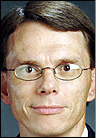The University of Arkansas formally opened its RFID Research Center on June 10, 2005. The center is headed by Bill Hardgrave, the Edwin & Karlee Bradberry Chair in Information Systems and executive director of the Information Technology Research Institute (ITRC).
With the backing of Wal-Mart and other corporate sponsors, including ACNielsen, Deloitte, E. & J. Gallo Winery, J.B. Hunt Transport Services and Tyson Foods, the RFID Research Center has emerged as the preeminent RFID lab within academia. (Full disclosure: RFID Journal is a media sponsor of the lab.)
RFID Journal recently spoke with Hardgrave about what the research center has accomplished in its first year and what projects the lab has in the pipeline for the next 12 months. Here is an excerpt of that interview:
RFID Journal: When you look back on the lab’s first year, do you feel you’ve achieved your objectives so far?
Hardgrave: We were primarily focused on the retail/CPG supply chain. We wanted to establish a presence there and set up a lab around RFID applications in that sector. We wanted to advance the knowledge of RFID in the supply chain. I think we’ve done some good things. The study we did on RFID’s impact on out-of-stocks at Wal-Mart was helpful to the industry, and we continue to research around that. The setting up of the lab and research center has been helpful for a couple of reasons. In the first year, we had more than 1,100 visitors from some 500 companies come through the lab. We use that opportunity to educate people about what RFID is and is not. We’ve helped get people thinking about how RFID can be leveraged, not just in the supply chain but also in other areas. I think we’ve also helped drive adoption by helping the supplier community understand more about RFID and how it can be used with their products through the testing services that we offer. We’ve been successful in generating interest among students and faculty here. We’ve had more than 100 students work in the lab, take courses or work on research projects, and we’ve had 15 faculty members involved with the lab.
RFID Journal: What new developments or trends are you seeing in RFID?
Hardgrave: Wal-Mart’s use of RFID and the suppliers they brought on have pushed RFID forward. But we are seeing many other companies looking at RFID’s value proposition. They are doing it because they want to and think there is an ROI there. I think that type of approach will push RFID forward more rapidly in the next 12 months than we’ve seen previously. In the area of cold chain—temperature and environmental sensing—companies are looking to use RFID because they see a value proposition, and I think they are right. They are adopting the technology on their own terms, and it will move things along rapidly. Tracking big-ticket items is another area. Again, companies [looking at this application] see an ROI. Those two areas will push RFID forward in the next year. That’s not to say tracking pallets and cases in the supply chain will be forgotten, but I think we are going to see lots of facilitators in this area, not just Wal-Mart.RFID Journal: How has the lab adapted to the changes in the industry?
Hardgrave: It’s been a natural, evolutionary change for us. We started off focused on the supply chain. Like those in industry, we learned a lot about what RFID could and could not do, and what some of the early wins are. The insights that we gained about the benefits from tagging cases in the supply chain enabled us to see that the benefits were even greater if you add the ability to monitor the temperature and condition of the product. We began looking at what this could mean for the ultimate quality of that product. We’ve used what we learned about RFID in the supply chain to broaden our research into other areas that could help companies be more competitive than others in their industries.
RFID Journal: You said 15 faculty members have been involved with work in the lab. What disciplines do they come from?
Hardgrave: We’ve had faculty from industrial engineering, electrical engineering, computer science, computing engineering, logistics, animal science, political science and information systems—a wide variety of disciplines.
RFID Journal: How valuable has the lab been for students?
Hardgrave: It has generated a lot of interest among students. I have 14 students working in the lab right now. It’s a great experience for them. They hire our students and then, when they find out they have RFID experience, they move them onto RFID projects.
RFID Journal: Do you have any significant projects on the horizon?
Hardgrave: The two biggest areas of research for us are studies in the cold chain, improving the quality of product as it moves from factory or farm to the consumer and effective and efficient use of RFID to track big-ticket items. We are already working with a couple of end-user companies. The thing that is exciting about cold chain is RFID can change the way we look at food quality. If we understand more about the impact of changes in temperature and humidity as products move through the supply chain, we can potentially get the product to the shelf with a longer shelf life and better quality. We might be able to use RFID to reduce damage or reduce the onset of some type of bacterial growth by a certain percentage; that is potentially very valuable. People see the effect RFID can have on improving the condition of, say, lettuce, and all of a sudden others want to test its capability with apples or broccoli or meat products. It starts to spread very quickly. People want to do it because they want to get return. That’s why I think it can drive adoption quickly.


